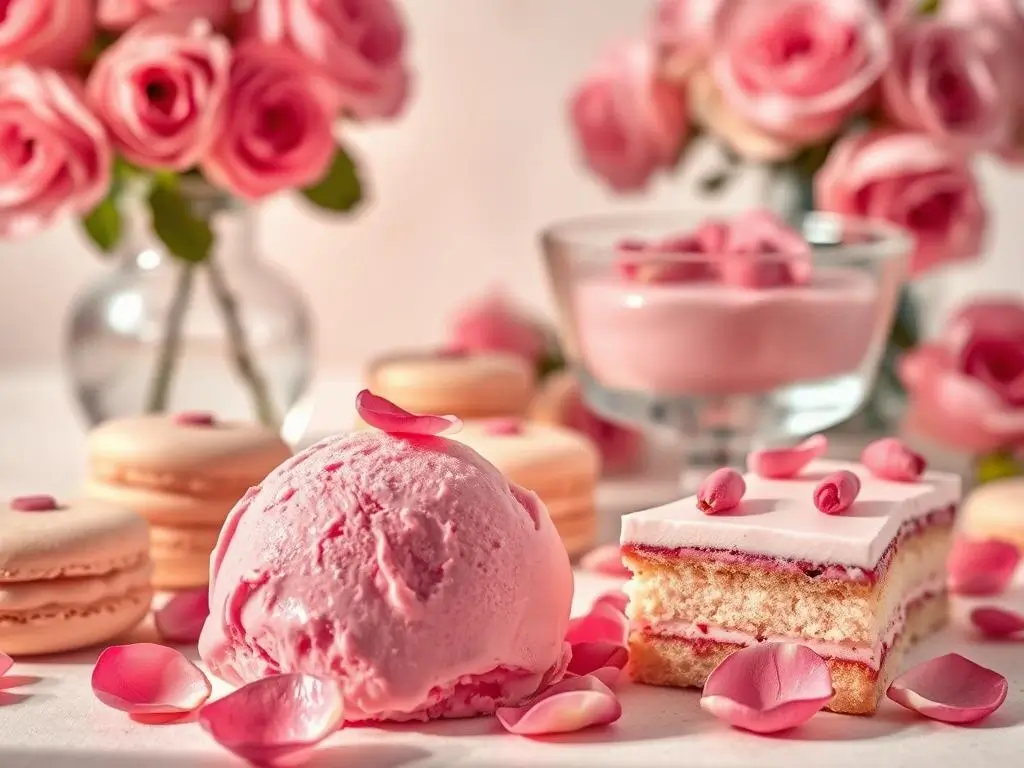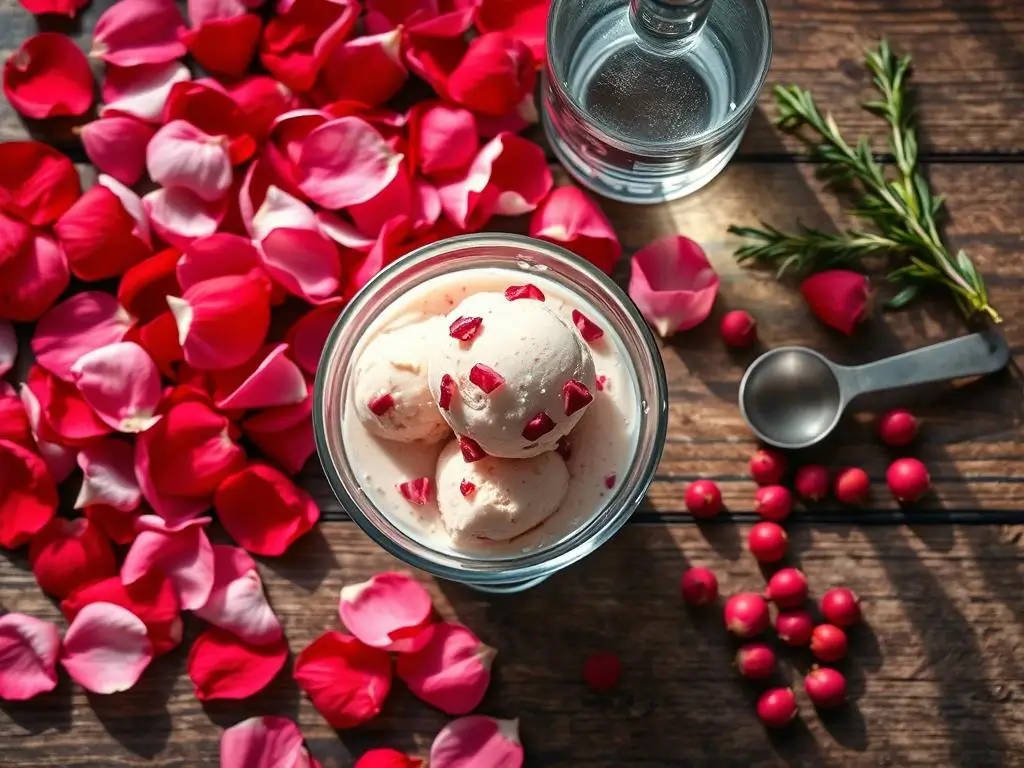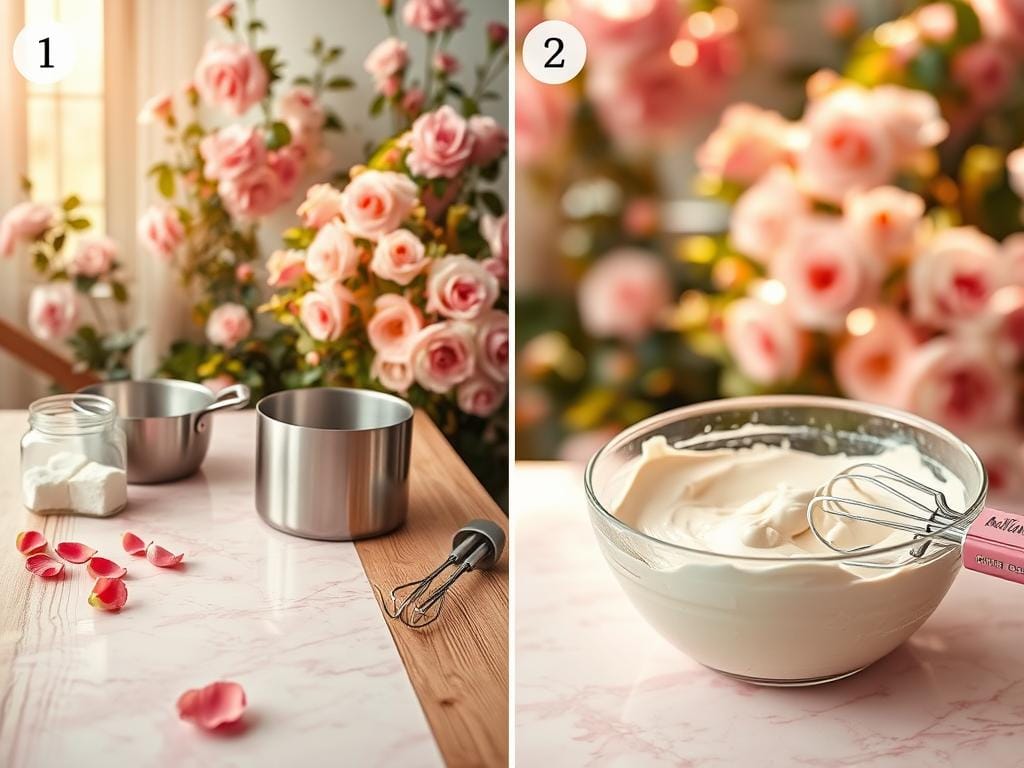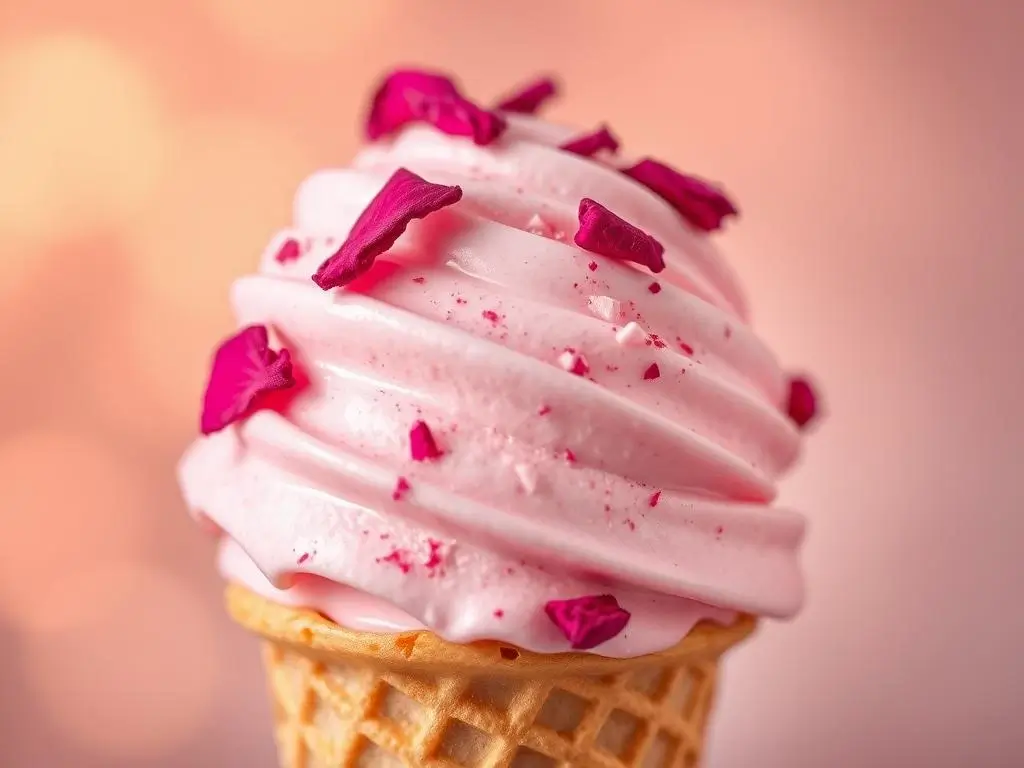Rose Ice Cream: Imagine a dessert that captures the essence of blooming gardens and time-honored traditions. This creamy creation blends delicate floral notes with rich, natural ingredients. It offers a refreshing escape from overly sweet, artificial alternatives.
Whether you’re a seasoned home chef or a curious beginner, this recipe invites you to explore a world where fresh petals and quality dairy take center stage. Unlike store-bought options, this homemade ice cream relies on real rose water and edible petals for its aromatic flavor.
Each spoonful evokes the simplicity of old-world techniques, updated with modern convenience. You won’t need specialty equipment—just a love for crafting desserts that prioritize authenticity over shortcuts.
The process begins with sourcing ingredients like fresh milk and a touch of vanilla extract. These elements combine to create a velvety base, while rose water adds a subtle, fragrant complexity. Even the preparation time is designed to fit busy schedules, proving gourmet results don’t require endless hours.
Key Takeaways
- Combines fresh petals and natural rose water for authentic flavor.
- No ice cream maker required—accessible for all skill levels.
- Uses high-quality dairy and minimal additives.
- Balances traditional methods with modern simplicity.
- Ideal for those seeking a less sugary, floral-inspired dessert.
Introduction to This Rose Ice Cream Recipe

For centuries, floral notes have elevated desserts from ordinary to extraordinary. From Middle Eastern gulab jamun to Indian falooda, rose-infused treats carry cultural significance. Today, this tradition meets modern creativity—but not all versions honor its roots.
Discovering the Allure of Rose-Infused Desserts
Many store-bought options rely on synthetic flavorings, leaving a cloying aftertaste. One customer shared how a neon-pink scoop tasted “like perfume mixed with sugar.” In contrast, artisanal methods use real petals and distilled rose water for a balanced profile.
What Makes This Recipe Unique
This approach draws inspiration from gelato masters who prioritize texture and subtlety. Instead of artificial dyes, it uses vanilla extract and honey to complement the floral essence. The method skips complex equipment—no ice cream maker required.
Trends like pink lattes dominate social media, yet they often lack depth. By blending heritage techniques with accessible steps, this recipe bridges tradition and convenience. You’ll discover how simple ingredients like milk and whipping cream transform into something extraordinary.
Up next: a deep dive into sourcing edible petals and mastering texture without stabilizers. Prepare to rethink what “homemade” truly means.
Essential Ingredients for Homemade Rose Ice Cream

The magic of this frozen treat starts with what you pour into your mixing bowl. Unlike mass-produced versions, every component serves a purpose—from creating silkiness to amplifying floral aromas.
Dairy, Rose, and Natural Sweeteners
| Ingredient | Quantity | Role |
|---|---|---|
| Heavy cream | 2 cups | Adds richness |
| Whole milk | 1 cup | Balances texture |
| Food-grade rose petals | ¼ cup | Infuses flavor |
| Rose water | 1 tbsp | Enhances aroma |
| Honey | ½ cup | Natural sweetener |
Pro tip: Steep dried petals in warm milk for 20 minutes. Strain before mixing with other ingredients. This unlocks subtle flavors without bitterness.
The Role of Vanilla, Honey, and Spices
Vanilla extract does more than sweeten—it grounds the floral notes. “A dash of real vanilla keeps the profile from feeling perfume-like,” notes pastry chef Lila Torres. Honey thickens the base naturally, while cardamom adds earthy warmth.
Crushed pistachios offer contrast. Their green hue pops against pale pink swirls. For color without dyes, try blending freeze-dried raspberries into the mixture.
“Quality rose water shouldn’t smell like soap. Look for bottles labeled ‘culinary-grade’—they’re distilled, not synthetic.”
Sweetened condensed milk (¾ cup) ensures creamy results without churning. Combined with fresh dairy, it creates that signature melt-in-your-mouth feel. Every spoonful whispers summer gardens, not sugar crashes.
Step-by-Step Guide to Crafting Your Rose Ice Cream

Transforming simple ingredients into a silky-smooth treat requires precision. Follow these steps to balance floral elegance with foolproof technique.
Infusing Milk with the Essence of Rose
Combine 1 cup whole milk and ¼ cup dried petals in a saucepan. Warm on low heat for 20 minutes—never let it boil. Strain through cheesecloth to remove solids. Chef Elena Martinez advises: “Patience here prevents bitter undertones. Watch for tiny bubbles at the pan’s edge as your cue to remove from heat.”
Simmering, Cooling, and Churning Techniques
Whisk 3 egg yolks with ½ cup honey until pale. Slowly pour in the infused milk while stirring. Return to low heat, stirring constantly for 8-10 minutes until thickened. Immediate refrigeration (4+ hours) locks in flavor.
| Method | Time | Texture | Pro Tip |
|---|---|---|---|
| Ice Cream Maker | 25 min | Airy & Light | Chill bowl 24hrs beforehand |
| Manual | 6hrs | Denser | Stir every 30min to break crystals |
Fold in 1 tsp vanilla extract during the last churn. For crunch, mix crushed pistachios into the base before freezing. Critical timing note: Overheated mixtures scramble eggs—use a candy thermometer (165°F max).
No machine? Pour into a shallow pan. Every 30 minutes for 4 hours, scrape frozen edges toward center. This mimics commercial churning for smoother results. The final product should glisten like morning dew on petals.
Tips for Perfecting Your Homemade Ice Cream
Elevate your dessert game with small tweaks that make a big difference. Whether you’re aiming for Instagram-worthy presentation or crave bold textures, these strategies help customize your creation.
Enhancing Flavor with Edible Flowers and Nuts
Add depth by folding crushed lavender or violet petals into the base. Pastry chef Marco Bianchi suggests: “A pinch of dried chamomile amplifies floral notes without overpowering.” For crunch, toast chopped pistachios and mix them in just before freezing.
Drizzle servings with warm honey infused with dried petals. Pair slices with cardamom-spiced shortbread for contrasting textures. Vintage glass bowls or marble slabs add visual charm—think rustic elegance over modern minimalism.
Creative Variations Without an Ice Cream Maker
No machine? Try the freeze-and-beat method:
- Pour the mixture into a shallow pan
- Freeze for 45 minutes
- Scrape edges toward center every 30 minutes
- Repeat 4-5 times
This breaks ice crystals for smoother results. For softer texture, add 1 tbsp vodka to the base—it lowers freezing points naturally.
| Issue | Fix |
|---|---|
| Too icy | Add ¼ cup sweetened condensed milk |
| Weak flavor | Steep petals 10 minutes longer |
| Overly firm | Thaw 8 minutes before scooping |
Store leftovers in airtight containers with parchment pressed against the surface. This prevents freezer burn while preserving freshness for up to two weeks.
Exploring the Science Behind Creamy Rose Ice Cream
The secret to velvety frozen desserts lies in balancing physics and flavor. While taste matters, texture determines whether your creation feels luxurious or grainy. Let’s break down how air, temperature, and ingredient chemistry work together.
Understanding Overrun and Ice Crystal Formation
Overrun refers to the air whipped into your base during churning. Commercial versions use 50-90% air to cut costs, but artisanal methods aim for 20-30%. This controlled expansion creates a lighter texture without sacrificing richness. Your manual stirring or machine churning directly impacts this ratio.
Ice crystals form as water molecules freeze. Smaller crystals (under 50 microns) feel smooth, while larger ones create crunchiness. Rapid freezing—like using pre-chilled bowls—limits crystal growth. That’s why recipes insist on frequent stirring: it disrupts forming clusters.
| Method | Air Incorporation | Average Crystal Size |
|---|---|---|
| Machine Churning | Consistent & even | 40-60 microns |
| Manual Stirring | Variable | 70-100 microns |
Whipping cream introduces fat globules that coat ice crystals, slowing their growth. Condensed milk adds sugars that lower the freezing point, preventing rock-hard results. Together, they create a stable emulsion where flavors like rose water shine without icy interference.
Quick chilling matters too. Freezing your mixture within 2 hours locks in tiny crystals. Let it sit too long at room temperature, and you’ll battle frosty textures. Precision turns kitchen experiments into spoonable elegance.
Best Rose Pistachio Cheesecake Ice Cream with Cream and Roses
Conclusion
Crafting this dessert is more than following steps—it’s an invitation to blend artistry with science in your kitchen. By combining culinary-grade rose water with fresh dairy and natural sweeteners, you create a treat that honors tradition while embracing modern simplicity. Every scoop reflects careful ingredient selection, from steeping petals to balancing air incorporation for velvety texture.
The process proves gourmet results don’t require specialty tools. Whether using an ice cream maker or manual methods, patience with chilling and stirring ensures smoothness. Experiment with crushed pistachios or vanilla bean accents, but preserve the floral essence that makes this recipe distinct.
Share your adaptations online—your twist might inspire others. Remember: quality ingredients like sweetened condensed milk and fresh petals elevate homemade creations from good to unforgettable. A few thoughtful tweaks can turn this timeless dessert into your signature masterpiece.
Ready to transform your kitchen into a flavor lab? Gather your bowls, embrace the science, and let each bite tell a story of creativity and care. This is a different recipe that you will like and find very useful. rose ice ream
Indulge in the Best Chocolate Ice Cream Recipe
FAQ
Can I substitute heavy cream with a lighter dairy option?
Yes, you can use half-and-half or whole milk for a lighter texture. However, this may slightly reduce the richness of the final product. For a non-dairy alternative, coconut milk works well.
How do I prevent ice crystals from forming during freezing?
Make sure the base mixture is really cold before you start churning. If you’re freezing without a machine, stir it often to stop crystals. Adding a bit of alcohol, like vodka, can also help.
Can I use fresh rose petals instead of dried ones?
Fresh rose petals need special care to avoid being bitter. Choose organic, pesticide-free ones. Dried culinary-grade petals are better for a consistent flavor.
What’s the purpose of vanilla in a floral-flavored dessert?
Vanilla balances out the strong floral taste. It also makes the dessert sweeter. Use a real vanilla bean or high-quality extract for the best flavor.
Is an ice cream maker necessary for this recipe?
No, you don’t need an ice cream maker. Just pour the mix into a shallow dish and freeze. Stir every 30 minutes for 3–4 hours to get a smooth texture.
How long can I store homemade rose ice cream?
Enjoy it within 1–2 weeks for the best taste. Keep it in an airtight container. Press parchment paper on the surface to stop freezer burn.
Can I make this recipe vegan-friendly?
Yes, you can. Use full-fat coconut milk instead of dairy. Replace honey with maple syrup. Add xanthan gum if it’s too runny.
What toppings pair well with this floral dessert?
Try crushed pistachios, edible flower petals, or honey for a nice touch. For extra texture, add rosewater-infused shortbread crumbles.

